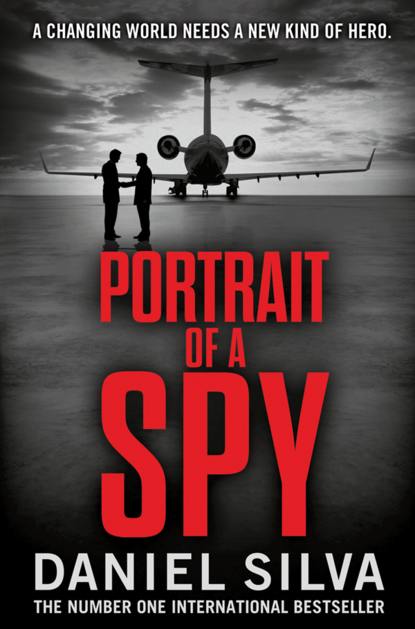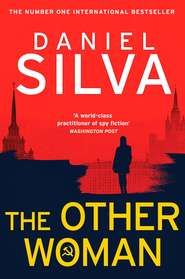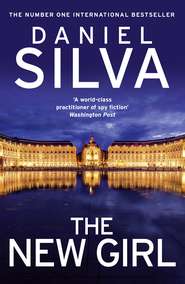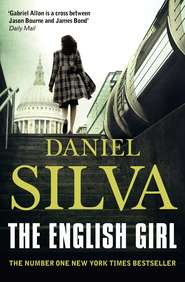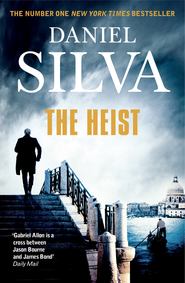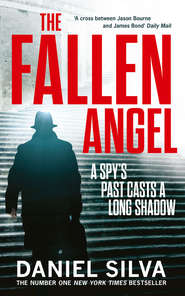По всем вопросам обращайтесь на: info@litportal.ru
(©) 2003-2024.
✖
Portrait of a Spy
Настройки чтения
Размер шрифта
Высота строк
Поля
He rounded the corner onto West Forty-ninth Street and walked a half block to the entrance of Christie’s. The soaring glass-walled lobby was a sea of diamonds, silk, ego, and collagen. Lovegrove paused briefly to kiss the perfumed cheek of a German packaging heiress before making his way to the coat check line, where he was promptly set upon by a pair of secondary dealers from the Upper East Side. He put them off with a defensive movement of his hand, then collected his bidding paddle and headed upstairs to the salesroom.
For all its intrigue and glamour, it was a surprisingly ordinary room, a cross between the United Nations General Assembly hall and the church of a television evangelist. The walls were a drab shade of gray-beige, as were the folding chairs, which were smashed tightly together to maximize the limited space. Behind the pulpitlike rostrum was a revolving display case and, next to the case, a bank of telephones staffed by a half-dozen Christie’s employees. Lovegrove glanced up at the sky suites, hoping to glimpse a face or two behind the tinted glass, then turned warily toward the reporters penned like cattle in the back corner. Concealing his paddle number, he hurried past them and headed to his usual seat at the front of the room. It was the Promised Land, the place where all dealers, consultants, and collectors hoped one day to sit. It was not a spot for the faint of heart or the short of cash. Lovegrove referred to it as “the kill zone.”
The auction was scheduled to begin at six. Francis Hunt, Christie’s chief auctioneer, granted his fidgety audience five additional minutes to find their seats before taking his place. He had polished manners and a droll English urbanity that for some inexplicable reason still made Americans feel inferior. In his right hand was the famous “black book” that held the secrets of the universe, at least as far as this evening was concerned. Each lot in the sale had its own page containing information such as the seller’s reserve, a seating chart showing the location of expected bidders, and Hunt’s strategy for extracting the highest possible price. Lovegrove’s name appeared on the page devoted to Lot 12, the Rothko. During a private presale viewing, Lovegrove had hinted he might be interested, but only if the price was right and the stars were in proper alignment. Hunt knew Lovegrove was lying, of course. Hunt knew everything.
He wished the audience a pleasant evening, then, with all the fanfare of a maître d’ summoning a party of four, said, “Lot One, the Twombly.” The bidding commenced immediately, moving swiftly upward in hundred-thousand-dollar increments. The auctioneer deftly managed the process with the help of two immaculately coiffed spotters who strutted and posed behind the rostrum like a pair of male models at a photo shoot. Lovegrove might have been impressed with the performance had he not known it was all carefully choreographed and rehearsed in advance. At one million five, the bidding stalled, only to be revived by a telephone bid for one million six. Five more bids followed in quick succession, at which point the bidding paused for a second time. “The bid is two point one million, with Cordelia on the telephone,” Hunt intoned, eyes moving seductively from bidder to bidder. “It’s not with you, madam. Nor with you, sir. Two point one, on the telephone, for the Twombly. Fair warning now. Last chance.” Down came the gavel with a sharp crack. “Thank you,” murmured Hunt as he recorded the transaction in his black book.
After the Twombly, it was the Lichtenstein, followed by the Basquiat, the Diebenkorn, the De Kooning, the Johns, the Pollock, and a parade of Warhols. Each work fetched more than the presale estimate and more than the previous lot. It was no accident; Hunt had cleverly stacked the deck to create an ascending scale of excitement. By the time Lot 12 slid onto the display case, he had the audience and the bidders exactly where he wanted them.
“On my right we have the Rothko,” he announced. “Shall we start the bidding at twelve million?”
It was two million above the presale estimate, a signal that Hunt expected the work to go big. Lovegrove drew a mobile phone from the breast pocket of his Brioni suit jacket and dialed a number in Paris. Hamdali answered. He had a voice like warm tea sweetened with honey.
“My client would like to get a sense of the room before making a first bid.”
“Wise move.”
Lovegrove placed the phone on his lap and folded his hands. It quickly became apparent they were in for a tough fight. Bids flew at Hunt from all corners of the room and from the Christie’s staff manning the telephones. Hector Candiotti, art adviser to a Belgian industrial magnate, was holding his paddle in the air like a crossing guard, a blusterous bidding technique known as steamrolling. Tony Berringer, who worked for a Russian aluminum oligarch, was bidding as though his life depended on it, which was not beyond the realm of possibility. Lovegrove waited until the price reached thirty million before picking up the phone again.
“Well?” he asked calmly.
“Not yet, Mr. Lovegrove.”
This time, Lovegrove kept the phone pressed to his ear. In Paris, Hamdali was speaking to someone in Arabic. Unfortunately, it was not one of the several languages Lovegrove spoke fluently. Biding his time, he surveyed the sky suites, searching for secret bidders. In one he noticed a beautiful young woman holding a mobile phone. After a few seconds, Lovegrove noticed something else. When Hamdali was speaking, the woman was sitting silently. And when the woman was speaking, Hamdali was saying nothing. It was probably a coincidence, he thought. But then again, maybe not.
“Perhaps it’s time to test the waters,” suggested Lovegrove, his eyes on the woman in the skybox.
“Perhaps you’re right,” answered Hamdali. “One moment, please.”
Hamdali murmured a few words in Arabic. A few seconds later, the woman in the skybox spoke into her mobile phone. Then, in English, Hamdali said, “The client agrees, Mr. Lovegrove. Please make your first bid.”
The current bid was thirty-four million. With the arch of a single eyebrow, Lovegrove raised it by another million.
“We have thirty-five,” said Hunt, in a tone that indicated a serious new predator had entered the fray. Hector Candiotti immediately countered, as did Tony Berringer. A pair of sparring telephone bidders pushed the price across the forty-million-dollar threshold. Then Jack Chambers, the real estate king, casually bid forty-one. Lovegrove wasn’t terribly worried about Jack. The affair with that little tart in New Jersey had cost him dearly in the divorce. Jack wasn’t liquid enough to go the distance.
“The bid is forty-one against you,” Lovegrove murmured into the telephone.
“The client believes there is a great deal of posturing going on.”
“It’s an art auction at Christie’s. Posturing is de rigueur.”
“Patience, Mr. Lovegrove.”
Lovegrove kept his eyes on the woman in the skybox as the bidding cracked the fifty-million-dollar threshold. Jack Chambers made a final bid at sixty; Tony Berringer and his Russian gangster did the honors at seventy. Hector Candiotti responded by waving the white flag.
“It looks like it’s down to us and the Russian,” Lovegrove said to the man in Paris.
“My client doesn’t care for Russians.”
“What would your client like to do about it?”
“What is Rothko’s record at auction?”
“Seventy-two and change.”
“Please bid seventy-five.”
“It’s too much. You’ll never—”
“Place the bid, Mr. Lovegrove.”
Lovegrove arched an eyebrow and raised five fingers. “The bid is seventy-five million,” said Hunt. “It’s not with you, sir. Nor with you. Seventy-five million, for the Rothko. Fair warning now. Last chance. All done?”
Crack.
A gasp rose in the room. Lovegrove looked up at the skybox, but the woman was gone.
Chapter 9
The Lizard Peninsula, Cornwall
WITH THE APPROVAL OF SCOTLAND YARD, the Home Office, and the British prime minister himself, Gabriel and Chiara returned to Cornwall three days after the bombing in Covent Garden. Madonna and Child with Mary Magdalene, oil on canvas, 110 by 92 centimeters, arrived at ten the following morning. After carefully removing the painting from its protective coffin, Gabriel placed it on an antique oak easel in the living room and spent the remainder of the afternoon studying the X-rays. The ghostly images only strengthened his opinion that the painting was indeed a Titian, and a very good Titian at that.
It had been several months since Gabriel had laid hands on a painting, and he was eager to begin work right away. Rising early the following morning, he prepared a bowl of café au lait and immediately threw himself into the delicate task of relining the canvas. The first step involved adhering tissue paper over the image to avoid further paint losses during the procedure. There were a number of over-the-counter glues suitable for the task, but Gabriel always preferred to mix his own adhesive using the recipe he had learned in Venice from the master restorer Umberto Conti—pellets of rabbit-skin glue dissolved in a mixture of water, vinegar, ox bile, and molasses.
He simmered the noxious-smelling concoction on the kitchen stove until it was the consistency of syrup, and watched the morning news on the BBC while waiting for the mixture to cool. Farid Khan was now a household name in the United Kingdom. Given the precise timing of his attack, Scotland Yard and British intelligence were operating under the assumption it was linked to the bombings in Paris and Copenhagen. Still unclear was the terrorist affiliation of the bombers. Debate among the television experts was intense, with one camp proclaiming the attacks were orchestrated by al-Qaeda’s old-line leadership in Pakistan and another declaring that they were clearly the work of a new network that had yet to produce a blip on the radar screens of Western intelligence. Whatever the case, European authorities were bracing for more bloodshed. MI5’s Joint Terrorism Analysis Center had raised the threat level to “critical,” meaning another attack was expected imminently.
Gabriel focused most intently on a report dealing with questions over Scotland Yard’s conduct in the minutes before the attack. In a carefully worded statement, the commissioner of the Metropolitan Police acknowledged receiving a warning about a suspicious man in an oversized coat headed toward Covent Garden. Regrettably, said the commissioner, the tip did not rise to the level of specificity required for lethal action. He then confirmed that two SO19 officers had been dispatched to Covent Garden but said they had no choice under existing policy but to hold their fire. As for reports of a weapon being drawn, police had questioned the man involved and determined it was not a gun but a camera. For reasons of privacy, the man’s identity would not be revealed. The press appeared to accept the Met’s version of events, as did the civil libertarians, who applauded the restraint shown by the police even if it had meant the loss of eighteen innocent lives.
Gabriel switched off the television as Chiara entered the kitchen. She immediately opened a window to drive out the stench of the ox bile and vinegar and berated Gabriel for fouling her favorite stainless steel saucepan. Gabriel only smiled and dipped the tip of his forefinger into the mixture. It was now cool enough to use. With Chiara peering over his shoulder, he applied the glue evenly over the yellowed varnish and adhered several rectangles of tissue paper to the surface. Titian’s handiwork was now invisible and would remain so for the next several days, until the relining was complete.
Gabriel could do no more work that morning except to check on the painting periodically to make certain the glue was drying properly. He sat in the covered gazebo overlooking the sea, a notebook computer on his lap, and scoured the Internet for more information about the three bombings. He was tempted to check in with King Saul Boulevard but thought better of it. He had neglected to inform Tel Aviv of his brush with terror in Covent Garden, and to do so now would only give his former colleagues an excuse to intrude on his life. Gabriel had learned from experience it was best to treat the Office like a jilted lover. Contact had to be kept to a minimum and was best conducted in public places where a messy scene would be inappropriate.
Shortly before noon, the last remnants of a midnight gale passed over Gunwalloe Cove, leaving in its wake a clear sky of crystalline blue. After making one final check of the painting, Gabriel pulled on an anorak and a pair of hiking boots and headed out for his daily march along the cliffs. The previous afternoon he had trooped north along the Coastal Path to Praa Sands. Now he mounted the small rise behind the cottage and headed south toward Lizard Point.
It did not take long for the magic of the Cornish coast to chase away the memories of the dead and wounded in Covent Garden. Indeed, by the time Gabriel had reached the fringes of Mullion Golf Club, the last terrible image was safely concealed beneath a layer of obliterating paint. As he pressed farther south, past the rocky outcropping of the Polurrian Cliffs, he thought only of the work to be done on the Titian. Tomorrow he would carefully remove the painting from its stretcher and then adhere the weakened canvas to a swath of fresh Italian linen, pressing it firmly into place with a heavy tailoring iron. Next came the longest and most arduous phase of the restoration—removing the cracked and yellowed varnish and retouching those portions of the painting lost to time and stress. While some restorers tended to be aggressive in their retouching, Gabriel was known throughout the art world for the lightness of his touch and his uncanny ability to mimic the brushstrokes of the Old Masters. He believed it was the duty of a restorer to come and go without being seen, leaving no evidence of his presence other than a painting returned to its original glory.
By the time Gabriel reached the northern end of Kynance Cove, a line of dark clouds had obscured the sun, and the sea wind had turned markedly colder. A keen observer of Cornwall’s capricious weather, he could see that the “bright interval,” as British meteorologists liked to call periods of sunshine, was about to come to an abrupt end. He paused for a moment, debating where to take shelter. To the east, across a patchwork-quilt landscape, was Lizard village. Directly ahead was the point. Gabriel chose the second option. He didn’t want to shorten his walk over something as trivial as a passing squall. Besides, there was a good café atop the cliffs where he could wait out the storm over a freshly baked scone and a pot of tea.
He turned up the collar of his anorak and headed along the rim of the cove as the first rain began to fall. The café appeared, veiled in mist. At the base of the cliffs, sheltering against the leeward side of the derelict boathouse, was a man in his mid-twenties with short hair and sunglasses propped on his head. A second man was loitering atop the observation point, his eye pressed to a coin-operated telescope. Gabriel knew with certainty it had been inoperative for months.
He slowed to a stop and looked toward the café just as a third man stepped onto the terrace. He wore a waterproof hat pulled close to his brow and a pair of rimless eyeglasses favored by German intellectuals and Swiss bankers. His expression was one of impatience—a busy executive who had been forced by his wife to take a holiday. He stared directly at Gabriel for a long moment before lifting his thick wrist toward his face and consulting his watch. Gabriel was tempted to turn in the opposite direction. Instead, he lowered his gaze to the footpath and walked on. Better to do it in public, he thought. It would reduce the chances of a messy scene.
Chapter 10
Lizard Point, Cornwall
DID YOU REALLY HAVE TO order scones?” asked Uzi Navot resentfully.





